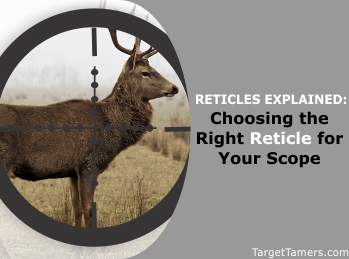
Searching for the right rifle scope for your hunting needs goes far beyond just buying the first one that'll look good on your rifle.
Not that we haven't all done that with at least one rifle scope buy, but there's more than just its aesthetically pleasing abilities that goes into getting the perfect scope for you.
Do you go with fixed or variable magnification?
Do you need parallax adjustment?
How about objective lens size?
Another factor that's just as important to remember is the type of reticle you should choose.
Whether you're playing around at the range, honing in on sniping skills, or putting tucker on the table, there's a reticle that's been made just for you.
So, here are some how-tos in navigating the reticle terrain.
What is a Rifle Scope Reticle?
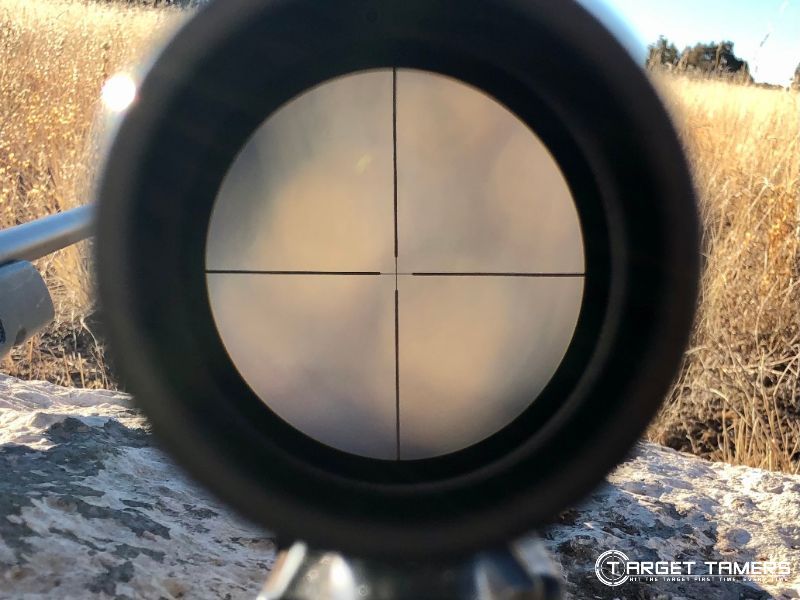
The reticle is the aiming point in your field of view in most rifle scopes. Also referred to as 'crosshairs' reticles are either glass etched or, most commonly, made out of wire.
Interpreting Reticle Terminology
As mentioned, the term reticle is often used interchangeably with cross hairs.
In our scope reviews, we refer to the reticle as a whole, and any distinctive feature of the reticle, such as the often seen perpendicular lines, we refer to as the cross hairs.
If there is a distinctly more dense, thick, or heavy part of the cross hair, we refer to this part as the post.
Hunting reticles are most commonly made out of wire, although the glass-etched reticles are becoming very popular in the hunting community for their durable, precise, and "unbreakable" reputation.
The Function of the Reticle
The purpose of reticles is to give you a centralized aiming point. Each reticle can be designed to cater to different shooting activities, hunting conditions, and even various types of targets. For example, there are are reticles for:
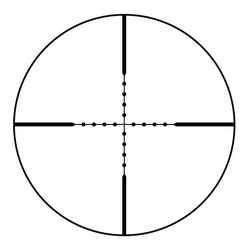
- Varmint hunting
- Hog/pig hunting
- Bullet drop compensation
- Laser rangefinding
- Low light shooting
- Tactical reticles
- General hunting reticles
- Illuminated reticles
TIP
Within just these few types of reticles, each optics manufacturer then applies their own name for the same design or style of reticle, such as Nikon's Nikoplex, Leupold's Duplex, and Weaver's Dual X for the standard Duplex style reticle.
Getting the Right Reticle for Your Scope
Making a choice of which style reticle you want can be a great feat.
And, how do you simplify it when Burris Optics has 27 reticle options?
Leupold doesn't make it any easier to navigate the horde when they have over 70 reticles available. Though, to their credit they have created a Reticle Viewer program where you can search their rifle scopes according to your choice of reticle.
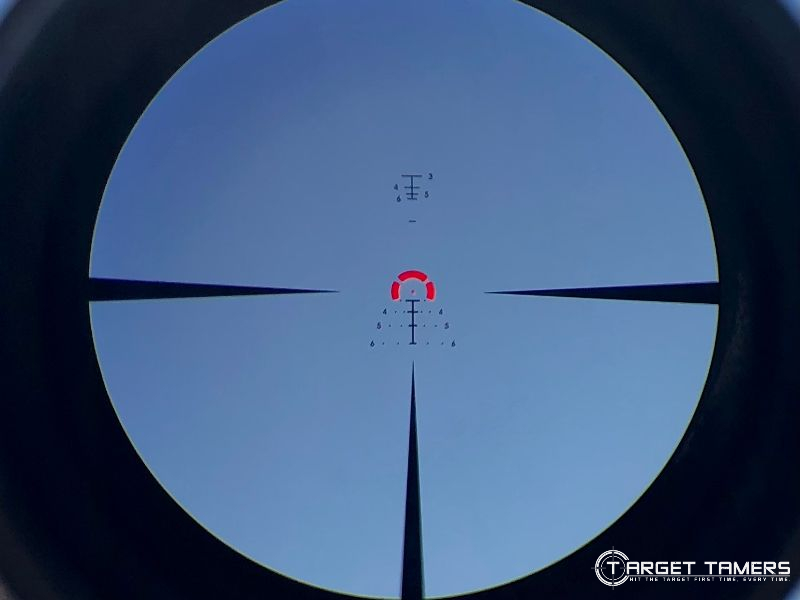
Another authoritative reticle maker in the optics industry is Horus. They specialize in some of the most intuitive and advanced reticles available in the market, period.
Horus offers incredibly fast and intuitive ballistic reticles that don't require you to holdover or "click" (make scope adjustments) to get dead on aim. They provide fast and repeatable results for multiple shots at extreme distances.
But, what do reticles look like and what distinctive features make each reticle different? Let's dive right into what has your brain ticking and your scope-drive chuggin'.
Different Types of Reticles to Choose From
1. Original Reticle
This reticle has done its job dutifully for many years. It features the single horizontal and single vertical cross hairs that cross in the center to create the aiming point of the reticle.
2. Dot Reticle
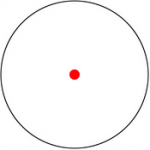
Perhaps one of the simplest reticles in the market. It features an enclosed circle - a dot, in the center of the reticle.
It can have cross hairs that emit from the top, bottom, left, and right of it that extend through the entire field of view.
3. German # Reticle
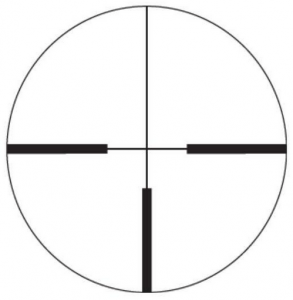
This is said as German number "x", whatever number reticle it is.
The most common and simplest reticles are the German #4 and the German #1. You'll see these reticles with thick right, bottom, and left (3, 6, and 9 o'clock) cross hairs that taper off towards the center in the original style or with a dot in the center. Sometimes it may or may not have a 12 o'clock/top cross hair.
These German reticles often come illuminated.
Our Leupold and Meopta reviews feature rifle scopes with the availability of the German #4 reticle.
The Zeiss Victory HT also has a similar #60 illuminated reticle.
4. Duplex Reticle
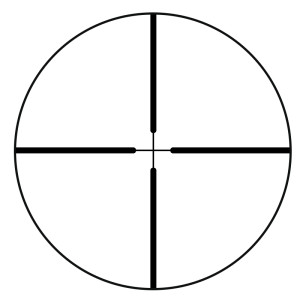
This is the most common style reticle that you'll find in hunting rifle scopes.
It's simple, uncluttered, and is considered the all-purpose reticle. The thicker posts of the four cross hairs will thin out to draw the eye to the center.
It's the all-round, perfect reticle for hunting in thicker brush or big game hunting where you need precision to strike the kill zone so it is no wonder the duplex reticle is considered by many to be the best hunting scope reticle.
Each manufacturer will have their own name for this standard style, such as Leupold's Duplex, Simmons' Truplex, Nikon's Nikoplex, and Weaver's Dual X reticles to name a few.
5. BDC Reticle
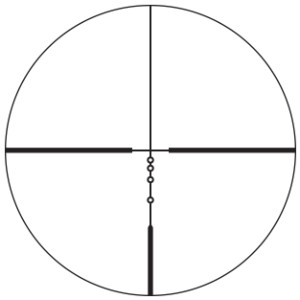
This stands for Bullet Drop Compensation and is a ballistics reticle. These reticles are capable of giving you a true point of aim for a known distance to compensate for bullet drop. This is very useful for long range hunters.
The distance markers may be hash marks, circles, or dots. The ballistic reticle can be simple and basic with only a few dots or lines on the 6 o'clock cross hair.
You can validate bullet drop at the range or with the use of the manufacturer's ballistic online program.
BDC reticles may even get more complex with specially distanced markings along both the 3 and 6 o'clock cross hairs.
It could even get more complicated than that with a "Christmas tree" style reticle design spanning across in part or the entire field of view.
Bushnell has the DOA 600 reticle that features dashes instead of circles, and Weaver has a glass-etched EBX reticle.
6. Mil Dot Reticle
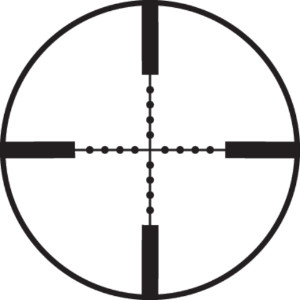
These ballistic reticles are measured in Miliradians (Mrad) where each dot on the reticle represents 1 Mrad that is equal to 3.6 inches at 100 yards/36 inches at 1000 yards.
It's not as common as MOA in the hunting category because it was specifically designed as a ranging reticle for the military. It came about so that you could use mil-dot to calculate the approximate size and the distance of your target as well as bullet drop.
While it's an ideal reticle for snipers and extreme long distance target shooters, hunters are finding that it helps them with making extreme long distance hunting shots as well.
7. Non-Illuminated Reticle
These reticles are simply black in color and don't have any built-in illumination abilities. This is fine for day time use, is cheaper than illuminated models, and is the standard for reticles today.
8. Illuminated Reticle
Any type of reticle can be made to be illuminated. Duplex, dot, BDC, varmint, and German reticles can all be illuminated. You'll see that center-illuminated reticles are very popular.
Some of the rifle scopes that we have reviewed that have center-lit reticles are the Victory HT, MeoPro, Swarovski Z6i, and the NightForce SHV. Check out our selection of the best illuminated reticle scopes here.
9. Christmas Tree Reticle
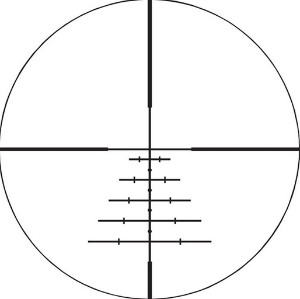
This type of reticle looks just like the shape of tree saved for the festive season.
The hash marks get relatively longer with each marking down on the 6 o'clock cross hair. This is to compensate for wind drift as your bullet strike and velocity is greatly affected at long range distances.
While there are some of these ballistic or BDC style reticles available in hunting rifle scopes, it's more commonly found in the hunting/tactical hybrids, tactical, mil-dot, and military rifle scopes.
Features of Reticles to Consider
Here are three steps to help identify which aspects of a reticle will best suit your hunting needs.
1. Consider the Center Feature
Look at the center point of the reticle. Does it have a cross, an open circle, a dot? The center point of the reticle is very important since it's indicative of where you intend your bullet strike to be.
Some things to think about when choosing a reticle with a distinctive center feature is...
- Will it interfere with my vision of the target?
- Will it obscure vital kill-zones of my target when I zoom in?
- Do I prefer it to stay the same size as I change magnification?
- Do I prefer it to increase in size as I increase magnification?
- Is it visible on a low magnification setting?
2. Check the Manufacturer's Description
Dots, hash marks, stadia lines, circles... they all mean something, and yet they can mean nothing if you don't know what you're looking at.
Pay attention to the manufacturer's description of the reticle. These distinctive features that are either present on the cross hair, post, or on the entire lens image may be indicative of a bullet drop compensator as a hold over point, a distance marker, or both.
These dots, lines, and various other features will represent a yardage distance that are all just estimates unless you've validated that at the range. It's important to double check the trajectory travel of the specific load you're using to ensure you'll be dead on.
If you're using electronic applications via your smart phone or computer, you can print off or view the given yardage estimates for the holdover values that each line or dot will represent with the manufacturer's online ballistic program. All the guess work is eliminated and the math done for you.
3. Consider Thick vs Thin
Thick or thin cross hairs? The posts of the reticle have a large part to play in how your eye sees the image through the scope.
- Thick - Hunters like heavy or thick cross hairs because they're easily visible and they instantly draw your eye to the center/aiming point of the reticle. They're also excellent to see against busy backgrounds. Even though the posts of the cross hairs may be thick, almost all reticles will thin out or become finer towards the center. If it's a BDC or ballistic reticle, the top of the post will usually represent a long range distance. Thicker cross hairs will also give you an added advantage of being able to see them against a background in low light conditions.
- Thin - If you're more concerned with minimal subtension and hair-splitting accuracy, then fine cross hairs are best for you. While they may not be the best against a busy background, fine cross hairs often come illuminated for improved visibility during the day or night. One of the purest and finest center-illuminated reticles is the Carl Zeiss #60, and in close competition is the more affordable Meopta RedZone Illuminated Reticle System.
Now that you know what types of reticles are out there, let's go over how reticle subtensions can affect your hunt.
Reticle Subtension Explained
What is Subtension?
Subtension refers to the amount of space the cross hairs cover on the target. Subtension is affected by both cross hair density and placement of the reticle inside the erector tube.
Thinner cross hairs equals minimal subtension. These are excellent for precise target shooting but can easily get lost in a cluttered background.
Thicker cross hairs equals increased subtension which are easily seen but can distract or cover important features of your target.
But as mentioned, not only does cross hair density affect subtension, placement of the reticle inside the erector tube applies here too.
When you see a rifle scope marketed with FFP and SFP, it is a direct indication of what to expect in relation to cross hair subtensions.
Subtension on FFP Reticles
FFP means first or front focal plane. The reticle is located in front of the magnifying lens assembly.
When magnification is increased or decreased, the cross hairs increase and decrease in size relative to the target and subtension remains constant.
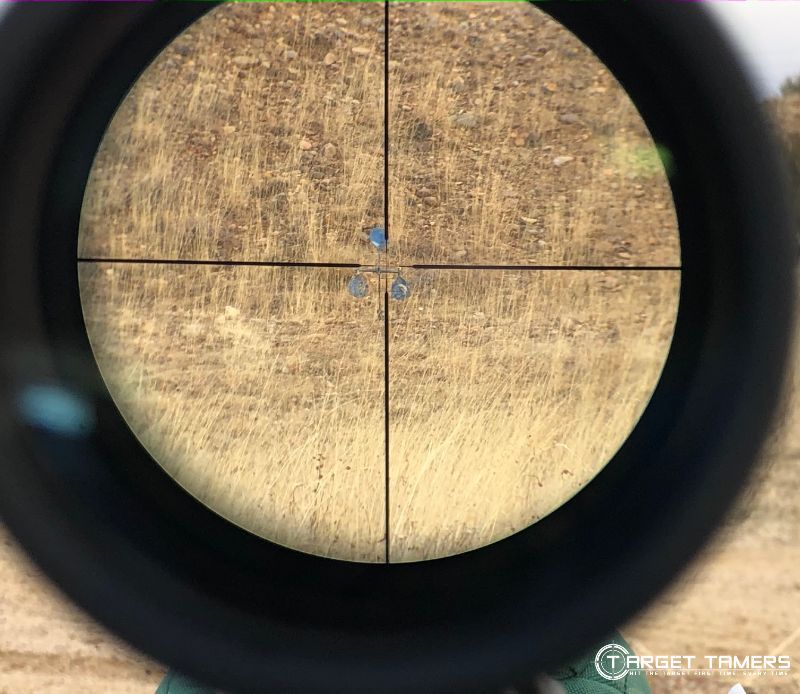
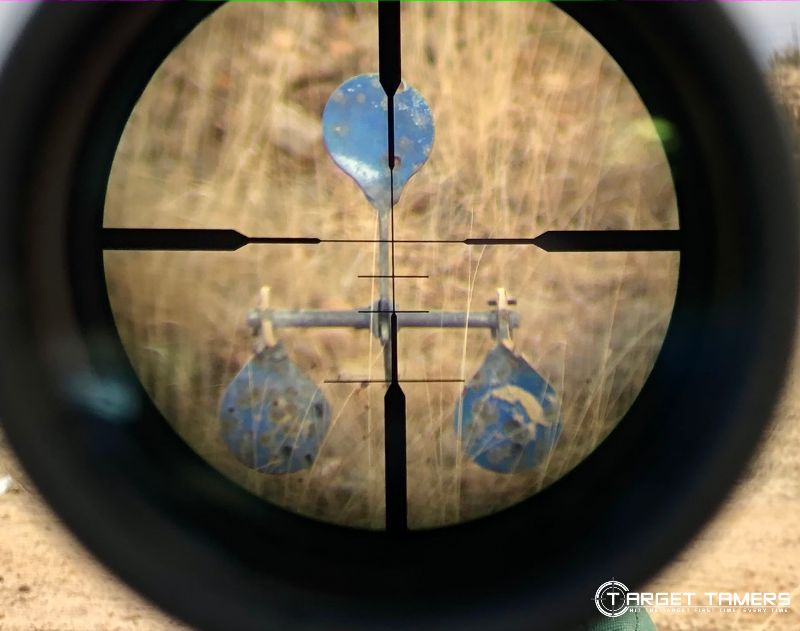
For example, the cross hairs and center point of the reticle increases in size as you increase magnification and your target gets larger. The amount of space your cross hairs cover on the target remains the same.
This allows for ballistic reticles to be used at any magnification because MOA or Mrad measurement increments will be accurate.
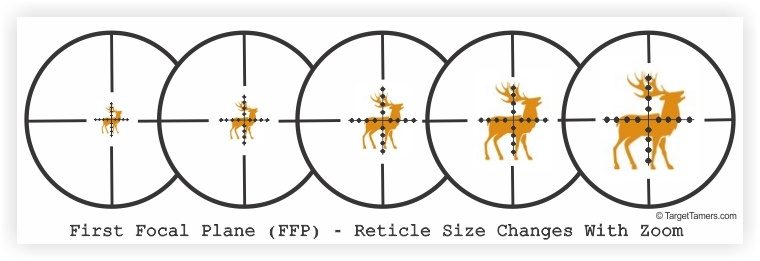
Some FFP rifle scopes that we've reviewed are the Bushnell Elite LRHS 3-12x44 and the Vortex Optics Viper PST 6-24X50 FFP.
Benefits of FFP Reticles
- Subtension remains the same
- Easily visible reticle
- Can use ballistic reticle in any magnification
- Ballistic and distance info in measurement increments on reticle is appropriate at all magnifications
Disadvantages of FFP Reticles
- Increased magnification and increased cross hair may cover vital features of your target
Subtension on SFP Reticles
SFP means second or rear focal plane. This is the most common design that most hunters and shooters will recognize. The reticle is located behind the magnifying lens assembly.
When magnification is increased or decreased, the cross hairs stay the same size despite the fact that the target changes in size. As a result, subtension is constantly changing.
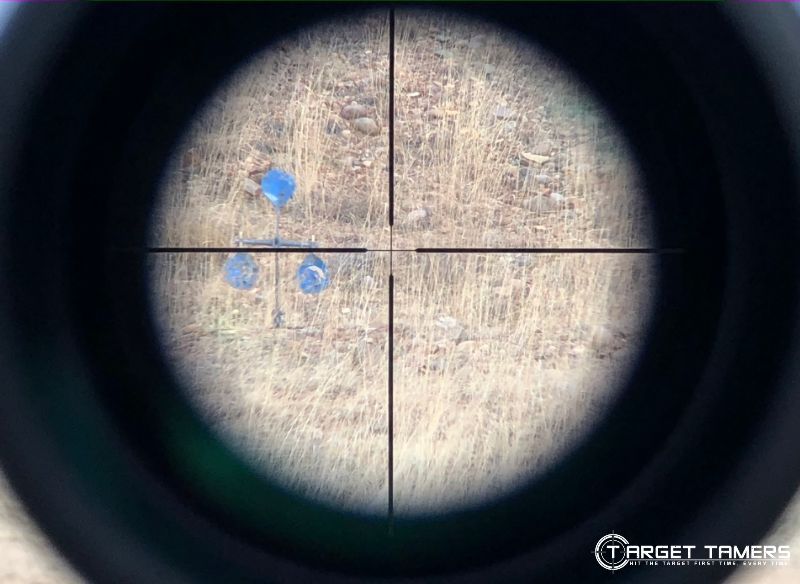
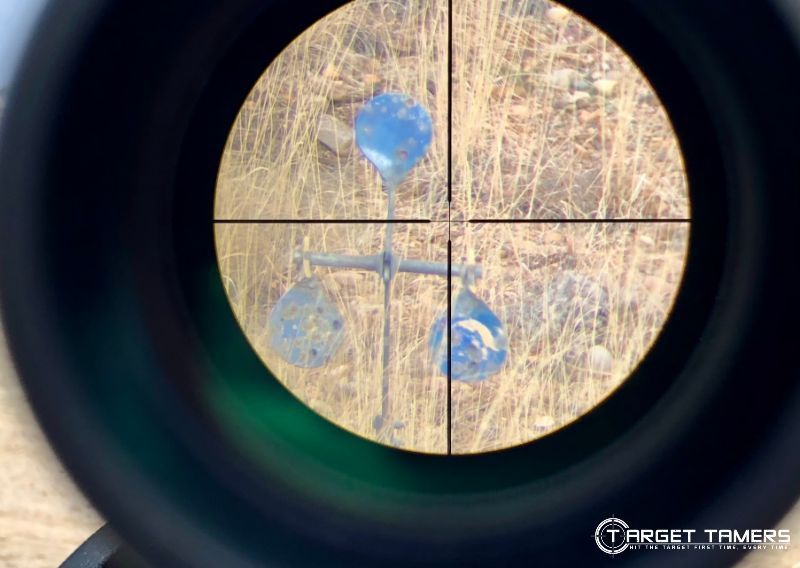
For example, the cross hairs don't get larger as the magnification and the target size is increased, they stay the same size. If you turn up your magnification, the target will get bigger and subtension will decrease.
The amount of space your cross hairs cover on the target will be constantly changing throughout the zooming process to cover less surface area of the target at high magnifications.
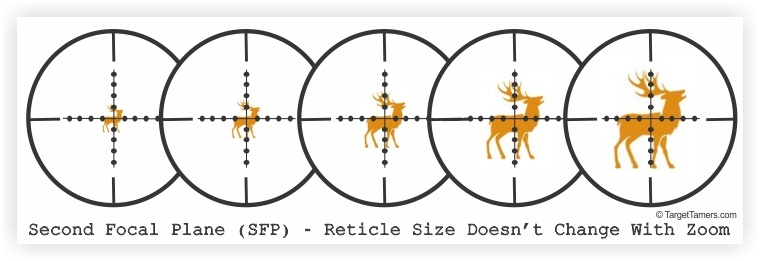
Some of the SFP rifle scopes that we've reviewed are the Maven RS.5 4-24x50, Meopta MeoStar R1r 3-12X56 RD, and the NightForce SHV 5-20X56 to name a few.
Benefits of SFP Reticles
- Subtension remains thin and minimal at high magnifications
- Ideal for long range hunting
- Provides better idea of bullet strike on very small targets
- Improves accuracy and preciseness
Disadvantages of SFP Reticles
- Can be difficult to see
- Can only use ballistic reticle at a preset magnification
- Ballistic reticle unusable at all other magnifications
We've Covered a Lot So Far...
If you're still with me, you must really be as passionate about shooting or optics as I am - I commend you.
But, stay with me a little longer.
Although we've covered the basics of what a reticle is, the different types, what they look like, and how they're going to look on your target out in the field, we still need to put all this information together to make it usable.
Here's a simple how-to to get you from amateur to expert the next time you're shopping for your lifetime scope purchase.
How to Choose Your Reticle
Step 1 - Firearm
Think about what firearm the scope is going to be mounted on. Scopes can be made to be versatile optics or they can be made for specific types of firearms.
A scope for a rifle will be mounted differently, have a different reticle, and added features than a scope made for a hand gun.
Step 2 - Intended User
Think about who is going to be using the firearm and scope. Do you want something that's practical and user-friendly or something a little more advanced with some neat bells and whistles thrown in?
Make sure that you can effectively use the scope for what it's made for.
Step 3 - Budget
Set a budget. Quickly piling on the illuminated reticles, the BDC features, and the extra hash marks here and there can cost you an arm and a leg.
Know how much you want to spend, or more realistically, know what you can't afford to spend on a reticle.
Step 4 - Intended Use
Narrow down your options by shooting activity and match it with the appropriate reticle.
If it's for long range hunting, you're going to want to look at the ballistic reticles. Check out this line-up of the best long range rifle scopes for some great options.
If you intend on staying out after dusk, perhaps an illuminated reticle will help.
Or perhaps you prefer practical, uncomplicated, and straightforward, then a simple duplex reticle will get 'er done.
The following list can be a mile long, but here are just a few suggestions to muse over.
- Illuminated Reticles - best for low light hunting scopes, dark conditions, and thin cross hairs to improve visibility with day or night time use
- Non-Illuminated Reticles - suitable for day time hunting of all kinds
- Duplex Reticles - Best with all types of hunting out to around 250 yards
- BDC Reticles - For long range hunting (250+ yards), long range target shooting, and shooting in mountainous terrain
- Christmas Tree Reticles - extreme long range shooting/hunting, tactical and military use
- Mil Dot - Practical use for those accustomed to Mrad measurements, tactical and military use
Step 5 - Magnification Considerations
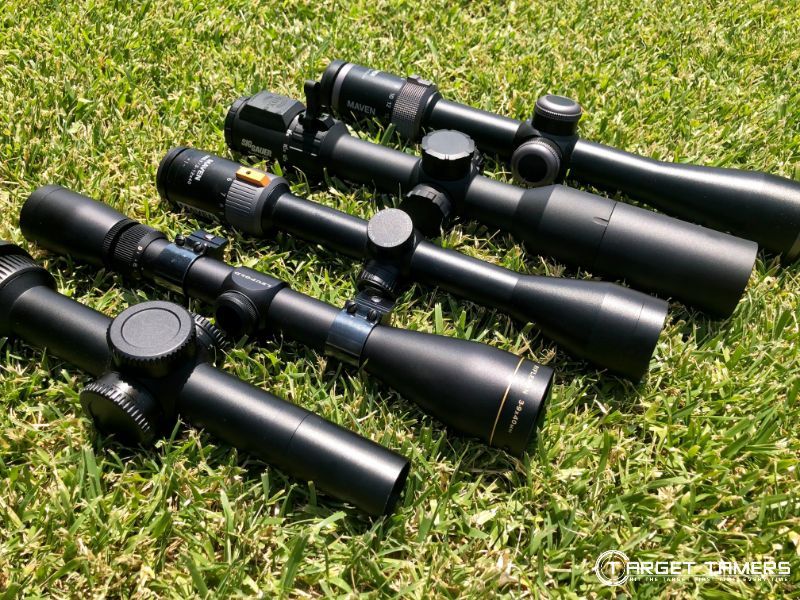
When buying a rifle scope, you next have to decide what magnification range is right for you. Fixed or variable are your options and it has a large part to do with the function of your reticle subtensions.
Here, you can also explore whether you prefer FFP or SFP reticles. Once you've decided this, you can move on to the next step.
Step 6 - Bells & Whistles
Consider added bells and whistles that you can throw into the mix to improve your shooting skills this hunt.
Optional features such as parallax adjustment and illuminated control affects reticle function and effectiveness.
The hard part of choosing the right reticle for you is over. With these tips and steps, you'll know exactly what to look for, be able to fully comprehend the jargon, and be able to establish realistic expectations out of your reticle.
So, lastly we come to the first thing you should do once you pull your brand new rifle scope out of the box...
How to Focus Your Reticle
This is a very vital and imperative step in getting your rifle scope ready for your hunt.
Focusing the reticle for your eyes has been explained in detail in our Rifle Scope Parallax article as well as our How to Mount & Sight Your New Rifle Scope article, so I won't bore you with that now.
But, for a quick instruction in less than 20 words, I'll give it a go.
- Eyes. Scope. Blank backdrop.
- Put it down. Turn eyepiece.
- Eyes. Scope. Reticle sharp, crisp, black?
- Repeat step 2. Again if necessary.
- Eyes. Scope. Perfect?
- Lock it.
Okay, so it's not 20 words it's 26 words, big deal. The point is, you must focus the reticle to your eyes.

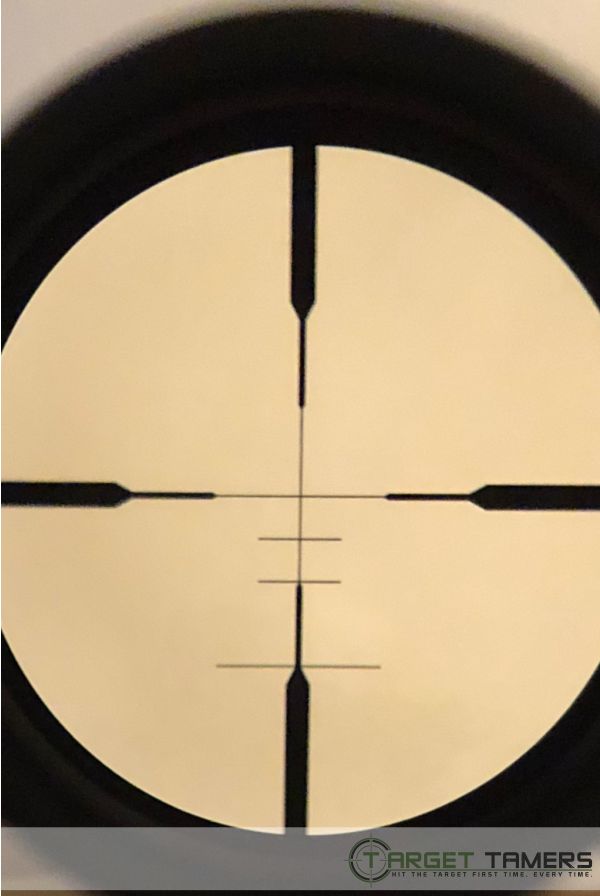
The reticle isn't being focused to the target, not to an image, and not to a distance. It's being focused to your unique vision.
The eyepiece is user-specific and shouldn't be adjusted again unless someone else used your scope or if there are drastic changes in the quality of your vision.
Ready to Scope Shop!
With all this reticle knowledge behind your back, you can be sure that you can make the most informed rifle scope purchase to fill your tag this season.
While an attractive scope sure looks good and quality glass is always important, the type of reticle you choose can be the difference between well-placed shots or never being invited on another hunt again.
Time to Shop? Check Out the Top RIFLE SCOPE Choices Right Here.
Further Reading




Excellent article! The information I needed. Thanks.
Glad you found it useful!
Mr. Cuthbert, Excellent article and you said much with few words! Well done!
Thanks Rollo, glad you found it useful
Almost 86 and still learning. Made lots of mistakes and bought lots of scopes at most price points and came to the same conclusions in this article. But it has been fun and lots of people made a little money from me and I don’t regret a moment of it. Very good explanations and visuals. Thank you for your work.
Signed: a gun/scope crank forever.......!
Thanks for taking the time to comment and for your feedback. Sounds like you are as addicted as we are! Crank on!
I'm replacing the crosshair wires in an old Mossberg scope and your article offered some nice insights. And hopefully some confidence.
Thanks for the feedback, glad it helped.
EXCELENTE RECOPILACION DE INFORMACION, MUY UTIL. GRACIAS
Muchas Gracias!
Simin,
The illustrated reticle ahead of the article , when illuminated in the center would be perfect for a muzzleloading rifle. The ranging elements below the red circle would be necessary for the trajectory of these large, slow moving slugs for any distance or projectile. Does anybody actually have such a reticle? 1-4x would be great!
Hi Gene. If you're talking about the mil-dot reticle, I've seen that most of the time the center crosshairs & dots are illuminated like in the Tacticon Apex Falcon 1-4x scope - this variation is very popular. Zeiss has the Reticle 43 that fits your description but not in a 1-4x. Others will have the center dot illuminated but no drop like the Vortex Crossfire II 1-4x with the V-Brite reticle. The Bushnell AR Optics 1-4x has the illuminated .223/5.56 BDC reticle but the non-illuminated Drop Zone BDC reticle fits the description better. Steiner has the P4Xi 1-4x with the P3TR reticle but its pricey with stadia lines instead of dots. There might have to be some compromise to find something similar to what you're looking for in the 1-4x LPV. If you find exactly what you're after, be sure to let us know!
TERRIFIC article ! A little mind numbing,and like you said I'm glad I stuck with you ! The way you explained the multitudes of options there are really helped me out ! Thank you
Thank you for the kind feedback Mark. We're glad you got something out of it!